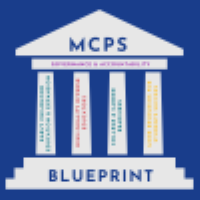The Blueprint for Maryland’s Future
What does the Blueprint Mean for Montgomery County Public Schools?
The Blueprint Law will fundamentally improve outcomes for students in MCPS as well as all public schools across the state of Maryland. The Blueprint brings an expansion of programs and initiatives that will expand access for all of our students, from Pre-K through Grade 12. Additionally, The Blueprint Law seeks to elevate “overall student performance to be among the world’s best and eliminates achievement and opportunity gaps between students from different family incomes, races, ethnicities, abilities and disabilities, and other defining characteristics.”

What is the Maryland's Blueprint for the Future Bill?
House Bills 1300 and 1372 Blueprint Background:
House Bill 1300 passed in 2020, and was vetoed by the governor due to uncertainty of COVID funding, and became law following a veto override in the 2021 session. The Blueprint for Maryland’s Future Act, House Bill 1372 passed in February 2021. It updated the Blueprint Bill and is considered a landmark generational piece of education reform legislation in the state of Maryland.
The Blueprint Law was developed from the work of the Kirwan Commission on Innovation in Education, and spanned over three years. Its work included benchmarking Maryland data against other high performing school districts nationwide and also internationally. Additional information that drove Commission’s work included a Funding Analysis Adequacy Study, Consultation with the National Center on Education and the Economy Framework (NCEE), an Equity Analysis conducted by Howard University, a Return on Investment Study by Strong Schools Maryland, and Support from the Maryland Department of Legislative Services.
The” Blueprint Law” was intended to enhance and improve state and local investments in, and school system operations in twenty- four MD jurisdictions on behalf of one million students, Pre-K through Grade 12. The ultimate goal is to make Maryland a high performing and world class system that is nationally and internationally competitive, over the next ten years. Its policy and funding recommendations were designed to move schools forward in a comprehensive way.
The Blueprint Law required each jurisdiction in Maryland to submit a comprehensive Blueprint Implementation Plan by June 15, 2022. The work of MCPS and its partners, such as offices within the Department of Health and Human Services, child care providers, and local colleges and universities, are all reflected in various aspects of the Blueprint Policies.
Blueprint Governance includes representation from the Office of the County Executive, Office of the County Council and MCPS. A process has been established that will work to engage stakeholders, and gather feedback and input that will be used to help develop recommendations for the Montgomery County Blueprint Plan Submission. Governance at the state level rests with a newly formed Accountability and Implementation Board (AIB), in conjunction with the Maryland State Department of Education (MSDE).

What the Blueprint Means for our MCPS Students:
- Expanded access to Pre-Kindergarten
- Additional Resources to support children with special needs, English language Learners, and those highly impacted by concentrated poverty and students struggling academically
- Increased Career Readiness Programs and Pathways and Dual Enrollment
- Behavioral Supports and Services
- Expanded wrap around services to “Community Schools”
Early Childhood Education and Expansion
- Expansion and increased access to a Pre-K program through a mixed delivery system, including both public and private programs. Program options should be made available to meet parent’s needs
- Expansion of full-day Pre-K at no cost for three and four-year-olds from families living at or below 300% of the Federal Poverty level. (FPL) in FY 23, and eventually makes it possible to serve 4-year olds from families between 300% and 600% of federal poverty level, using a sliding scale.
- By FY2023, eligible private providers should account for at least 30% of state funded Pre-K slots in the county. By FY 2026, that requirement increases to 50%. (Jurisdictions who are unable to meet this requirement may apply for a waiver.)
- All Pre-K programs must meet rigorous quality program standards (Attain MSDE Accreditation and enroll in the (Maryland EXCELS Quality Rating System)
- By FY 2026, all instructional assistants, in both public and private Pre-K programs, must have an associate’s degree or CDA (Child Development Associates)
- Develop and implement a new school readiness assessment for all students entering Kindergarten
- Increase funding for Infants and Toddlers, primarily managed by Department of Health and Human Services to identify needs early and provide and coordinate access to education and support for at risk children, ages 0-5 and their families.
- Expansion of Family Support Centers for pre- and post-natal support and Judy Centers for early education and support.
High-Quality Diverse Teachers and Leaders

Improved Recruiting & Professional Development
Improved recruiting and professional development efforts to create and sustain a teaching faculty that better reflects the racial and ethnic make-up of the student body.

Leadership Development System
Creation of a leadership development system that better prepares teachers at all levels- state, district and school. This system will give them the vision, skills, and knowledge that they need to implement the recommendations made in the Commission’s report and manage high performing schools.

Raising the Status of Teachers
Transforms teaching to a high-status profession by raising the status of teachers, including a performance-based career ladder, a minimum statewide beginning salary, and salaries comparable to similarly educated professionals and mandates increases for teachers.
College and Career Readiness Pathways, including Career and Technical Education (CTE)
- Students who meet the College and Career Ready (CCR) Standard will have access to a set of post CCR program pathways
- Maryland will adopt a standard set of global standards to certify that students have the requisite literacy skills (and when practicable Science) needed to succeed in first- year credit bearing community college courses.
- Alternative educational approaches will be developed for students in middle school and early high school who are not likely to meet the CCR standard by the end of 10th grade.
-
By FY 24, Alll students who meet CCR standards must have access to no-cost post CCR Pathways including the following:
- Competitive college preparation program, early college, dual enrollment, robust CTE, Programs and Credit or non- credit certificate or license program courses or apprenticeship leading to occupational credential or post-secondary certificate.
- MCPS will implement a 9th grade tracker system to measure each student’s progress towards graduating on time, including credit accumulation and report outcomes to the Maryland State Department of Education and Accountability and Implementation Board.
- Blueprint expands the definition of Career and Technical Education/CTE to include those taken through apprenticeship sponsors and expands dual enrollment to include non-credit courses leading to certificate or license.
- Blueprint creates a CTE committee within the Governor’s Workforce Development Board to develop a new statewide framework and set of standards Beginning FY 2024, CTE programs offered by public schools must be aligned with the CTE system developed by a newly formed CTE committee.
More Resources to Ensure All Students are Successful
New Supports
Broad and sustained new academic, social service, and health supports for students and schools that need them the most
Closing the Achievement Gap
Blueprint emphasizes closing the achievement gap and reducing disproportionate placement of students with particular racial, ethnic, linguistic, economic or disability status.
Addressing Equity
Aspects of the Blueprint will directly address equity and the final policy resource recommendations were driven by the belief that all students, regardless of family income, race, ethnicity, language spoken, disabilities or other needs, must have the resources they need for success.
Revising Funding Formulas
Revises funding formulas to increase funding for English language learners, Special education students, and those eligible for FARMS.
Training for Personnel
Certificated personnel who have direct contact with students on a regular basis must complete a training each year in order to identify professional resources to help students, recognize behavioral health issues, recognize students experiencing trauma and or violence outside of school.
Supplemental Instruction
Establishes Transitional Supplemental Instruction for struggling learners' program to provide additional support. Support will provide individual and small group instruction for students who are not on track and reading at grade level by third grade, secondary students who are not proficient in Mathematics.
Funding for High Poverty Schools
Creates Concentration of poverty grants for schools with high poverty and funds “Community schools” that will each have a full-time community schools coordinator.
Services through Partnerships
Through partnerships; will coordinate needed services including but not limited to, before and after care, social services, behavioral health support, tutoring, etc.
Blueprint for Maryland’s Future:
Workgroup on English Learners in Public Schools
Blueprint for Maryland’s Future:
Interim Report on Neighborhood Indicators of Poverty
Governance and Accountability
- Blueprint establishes an Accountability and Implementation Board (AIB) which has authority over MSDE and other state agencies in policy decisions and will do the following:
- Requires LEAs, Schools, county government and MSDE to submit reports
- Gather and disaggregate data on student achievement
- Review teacher preparation programs at colleges and universities
- Monitor FARMS concentration and diversity of students and staff in Pre-K-12 schools and full-day public and private Pre- K programs
- Ensure a sufficient number of teachers are in the career ladder
- Will send “expert review teams” to each jurisdiction to monitor implementation
- Will seek out statewide advisors to inform on the work implementation of the Blueprint
- For FY 2022 through FY 2026, the local governing body of each county, including school systems and local government shall jointly appoint a Blueprint Coordinator responsible for the implementation of the Blueprint by all units in the county.
- The AIB will develop a set of criteria for reporting and share with LEAs by February 15, 2022 and each LEA will be required to submit a final Blueprint Implementation Plan to the AIB by June 15, 2022.
- AIB will send out expert review teams to monitor Implementation progress in each of the LEAS and may withhold funds from school systems that are found to be out of compliance with the Blueprint.
- The AIB will develop a leadership development training program for Board of Education members and school principals
Contact Us
Maryland’s Blueprint for the Future
Phone: 240-740-5643
E-mail: Maria_I_Bouchard@mcpsmd.org









